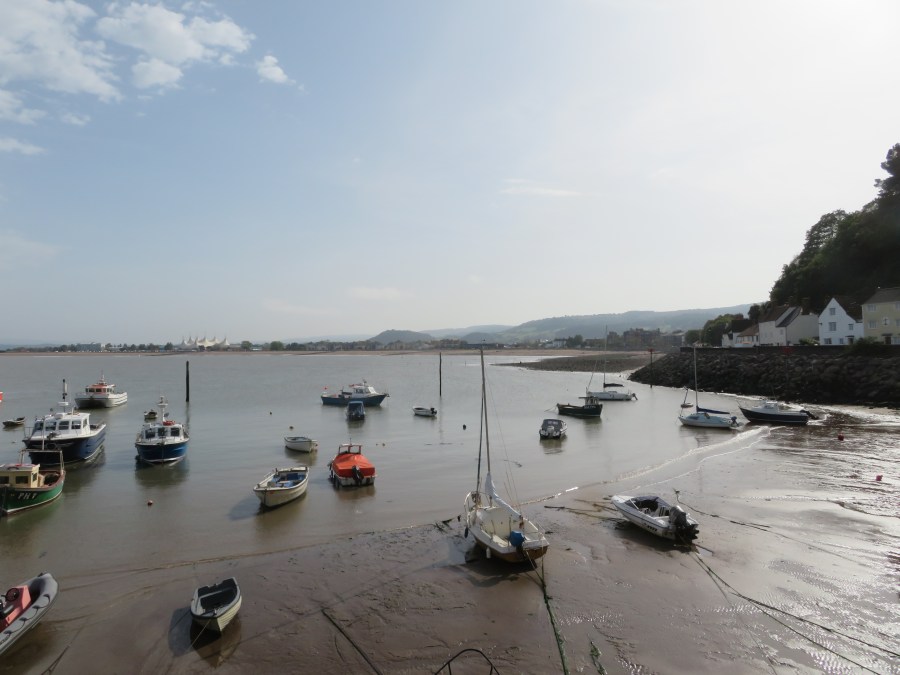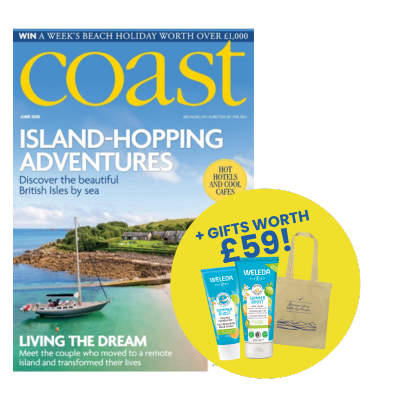This welcoming west Somerset beach town of Minehead is a gateway to the rural idylls of Exmoor National Park and the South West Coast Path, writes JENNY MACLEAN
After a long drive slaloming down country lanes to the edge of Exmoor, I’ve reached two conclusions. Firstly, this part of the country is gloriously devoid of traffic and glazed with shatterproof serenity. I’m visiting in autumn, when the summer crowds have melted away, but still…people live here, right? Secondly, I’m in desperate need of refreshment.
Arriving in Minehead, I pop my head into Apple Tree Tea Rooms on The Avenue, which is on the verge of closing for the day. Sensing my urgent need for cake, the owner – a lovely lady called Jacky – kindly serves me a generous slab of homemade Victoria sponge and a pot of tea, which I thoroughly enjoy on the patio in the late afternoon sun.
Cake fix complete, I wander in the direction of the beach and pad barefoot on the mile-long stretch of silky sand, breathing in the salty sea air, listening to the soothing cry of seagulls and watching locals brave the autumn water in bikinis.
When my soles are sufficiently sandy and my hair is knotted into a windswept tangle, I rest on the rocks and gaze out towards North Hill, which rises 900 feet above the town. Offering spectacular views over the Bristol Channel towards south Wales – and a grassy stomping ground for native Exmoor ponies and elusive red deer – North Hill is not only Minehead’s most distinctive landmark but also its namesake (‘mynydd’ means ‘mountain’ in Welsh).
Sand, sea and patisserie: the weekend has started very well indeed, and my mum’s arrival makes it all the sweeter.
Saturday morning begins with a slap-up breakfast at our hotel and a leisurely stroll up the rest of The Avenue. This leafy tree-lined street brims with independent shops and eateries like Exmoor Food & Crafts, which sells local products made by local people, and Flapjackery (“A whole shop filled with flapjacks!” mum exclaims in unbridled – and justifiable – delight).
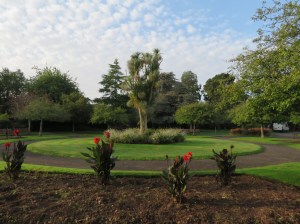
We discover an alleyway that leads to Blenheim Gardens, a tranquil area of parkland with a bandstand that’s been a go-to green space for locals since 1925 and plays host to a number of events throughout the year, including free summer concerts.
Magnetised by the ocean, we’re pulled in the direction of the promenade and walk north to the harbour, stopping to admire the eye-catching monument that marks the start of the 630-mile South West Coast Path. The first section leads to Porlock Weir, where walkers can claim a stamp in their Coast Path Passport, a long-awaited memento that launched in 2022 with 100 local businesses acting as checkpoints.
The harbour is a potpourri of bobbing boats, historical cannons, a fisherman’s chapel, a lively pub, Minehead’s RNLI base and a stony shoreline with a steep descent to the water – plus a selection of the town’s famous ‘metalheads’.
“You’ll see plenty of those about,” a local informs me as I inspect a smiling fisherman in yellow waders. “My favourite’s the one cycling home with a loaf of bread outside the bakery – I call him Bob.”
Bob and the fisherman, who I name Fred, are just two of nearly 200 curious characters made out of scrap metal by local former carpenter Steven Heard, who taught himself to weld during lockdown. Most are concentrated around The Avenue and The Parade, many are inspired by local businesses, and all can be found on the trail maps available at Minehead Information Centre.
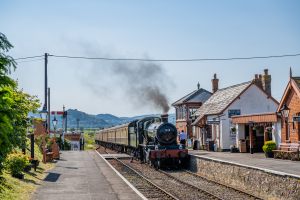
Our morning dawdle morphs into a zippy power walk after checking our watches, and we make it back to the station just in time to watch a steam train chug into town. The West Somerset Railway, which opened in 1874 and is England’s longest heritage line, triggered Minehead’s transformation from a remote seaside town within exclusive reach of the wealthy into an accessible tourist destination.
The railway remains popular to this day, attracting 200,000 passengers each year who partake in historic steam and diesel-powered experiences or simply enjoy the 20 miles of track that snake along the shores of the Bristol Channel and wind through the Quantock Hills.
The line links Minehead and Bishops Lydeard with eight stops in-between including Dunster, one of the most intact medieval villages in England with 200 listed buildings, a Yarn Market and a National Trust castle with a working watermill, and Watchet, home to fossil-rich Helwell Bay, a 160-year-old lighthouse and a statue of Coleridge’s Ancient Mariner.
Over a light lunch at The Turntable Cafe, handily located right on the platform, we set our sights on Dunster Castle. We pick up a brochure at the information centre across the road – also the access point for Minehead’s free museum (open mid-March to late October) and base for the Free Beach Toy Library, where visitors can borrow plastic toys others have left behind – then drive ten minutes to Dunster, where we spend a pleasant afternoon in the castle grounds and colourful village.
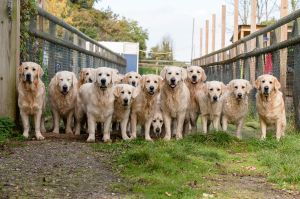
On the short journey back to Minehead, we pass the family-run Golden Retriever Experience. This unique activity is a must-do for dog lovers: I challenge anyone to rebuff the opportunity to cuddle and play with a 30-strong pack of trained golden retrievers for two glorious hours. It’s extremely popular and advisable to book well in advance.
There’s plenty more in store for animal aficionados, as we discover the next day. Meandering our way west through Exmoor National Park’s blissfully quiet roads, we pass herds of free-roaming ponies, clusters of cloud-like sheep and a lone long-horned Highland cow, all set against dizzying sweeps of greenery – then come face-to-face with feral goats clambering freely between ancient crags at Valley of Rocks, one of the most spectacular stretches of the South West Coast Path.
From the deep valley floor where a river once ran to the towering heights of climbable Castle Rock, the dramatic sea cliff scenery is well worth the 40-minute journey over the Somerset border into north Devon.
We return to Minehead via the twin villages of Lynton and Lynmouth, where the Cliff Railway has been rewarding riders with jaw-dropping views of the Devon coastline since 1888. It’s the UK’s only fully water-powered railway, and the highest and steepest water-powered railway in the world.
I can’t resist taking mum to Apple Tree Tea Rooms after our Exmoor adventures, where we savour homemade scones with whortleberry jam, the West Country name for the wild bilberries found growing on Exmoor and Dartmoor. The jam is so exquisite that we buy a jar to take home (and regret not buying more when we open it a few weeks later). We also discover that Jacky, like numerous other locals who we’ve chatted with over the weekend, retired here from another part of the UK – and frankly, I can see why.
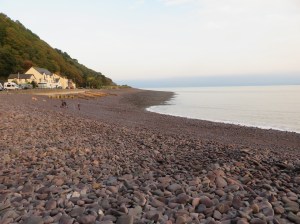
Our final evening is spent by the sea, where we treat ourselves to fish ’n’ chips after sundown. Before I know it, it’s time to bid adieu to the beach and head back to the home counties, where I reluctantly swap whortleberry jam for traffic jams – and question my sanity when I consider making the six-hour round trip next weekend for a slice of that Victoria sponge.
WHERE TO STAY
I stayed at Stones Hotel & Bar where rooms are basic but comfortable, the staff are friendly and the restaurant has a traditional pizza oven. Nearby alternatives include Waverley B&B (the breakfast gets rave reviews), The Beach Hotel (dog-friendly), Woodcombe Lodges & Cottages (for self-caterers) and Butlins (Minehead is one of three resorts in the UK).
My personal recommendation is Dunkery Beacon Country House, a peaceful countryside oasis with just eight rooms, including the first floor premier suite four-poster with bay windows and panoramic views. Standing at 519m above sea level, nearby Dunkery Beacon is the summit of Somerset and a Dark Sky Discovery Site – visit in October for the Dark Skies Festival.
WHERE TO EAT
For light meals:
Watch the steam trains or perhaps an engine being turned at The Turntable Cafe, which serves pasties, bacon rolls, jacket potatoes and West Country cream teas – all locally sourced where possible.
For big meals:
The Wheelhouse on The Avenue and The Old Ship Aground at the harbour serve home cooked, locally sourced food.
For a treat:
Flapjackery on The Avenue sells award-winning flapjacks handmade in Devon using British oats and locally sourced West Country ingredients. When you buy a box of three, a percentage of the proceeds are donated to Minehead RNLI.
For self-caterers:
Stuart Lowen Farm Shop stocks locally produced preserves, bread and cheeses, plus locally sourced fruit and veg. If you’re in the area on a Friday, the weekly Farmers’ Market runs from 8.30am to 2pm.

